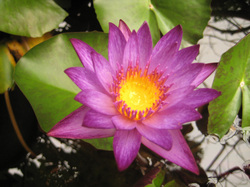 "Toward the end of his life, the Buddha took his disciples to a quiet pond for instruction. As they had done so many times before, the Buddha’s followers sat in a small circle around him, and waited for the teaching. But this time the Buddha had no words. He reached into the muck and pulled up a lotus flower. And he held it silently before them, its roots dripping mud and water. The disciples were greatly confused. Buddha quietly displayed the lotus to each of them. In turn, the disciples did their best to expound upon the meaning of the flower: what it symbolized, and how it fit into the body of Buddha’s teaching. When at last the Buddha came to his follower Mahakasyapa, the disciple suddenly understood. He smiled and began to laugh. Buddha handed the lotus to Mahakasyapa and began to speak. “I have experienced the true Dharma eye, the marvelous mind of Nirvana, the true form of the formless, the subtle Dharma Gate that does not rest on words or letters but is a special transmission outside of the scriptures. This I entrust to Mahākāśyapa.” ( www.katinkahesselink.net)
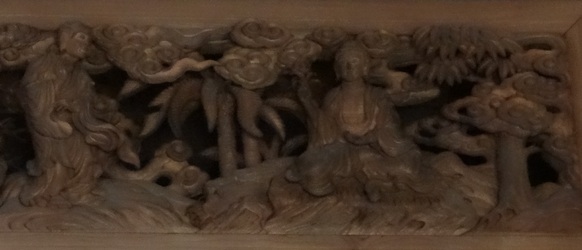 The story of the flower sermon, Buddha's transmission of the truth beyond words and letters, above the main altar of the Butsuden in Eiheiji monastery 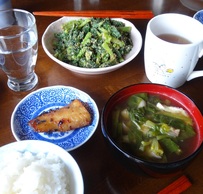 Miso soup was waiting for us! From Tokyo, Neda & I were excited to head up to the mountains of the Nagano prefecture, in the small town of Shiojiri, to visit our friends from Bodhgaya, India who had invited us to their hometown. When Rika first heard we actually were going to visit her up in the mountains, she was surprised and ecstatic. After all, she had invited other “gaijin” (foreigners) on her travels, but none had actually come to visit. She wrote excitedly, “Miso soup will be waiting for you!” and we knew that we were in for a warm welcome and looked forward to seeing Japanese culture from a more intimate perspective.
The first place we stopped was at Kouryu-ji Temple, the home of Toha-Osho and his family. Toha was one of two Zen Priests we met at Nippon-ji and he had taken care of us while we were in India. While we caught up over tea, we told Toha we would try to visit Eiheiji Temple after our visit with them, but only for the day because it seemed impossible to arrange for a longer visit when we called with Rika from India because we didn’t speak Japanese. It is a training monastery and they can only handle English speakers on specific dates when they have prepared for it. Eiheiji is an important place of pilgrimage for Neda and me because it is the home monastery of the Soto Zen Sect, which we practiced at the Austin Zen Center. We also talked to him about recommendations on where to buy some calligraphy, which we wanted as a souvenir from Japan. He told us, “Calligraphy very expensive to buy. I will make some for you.”
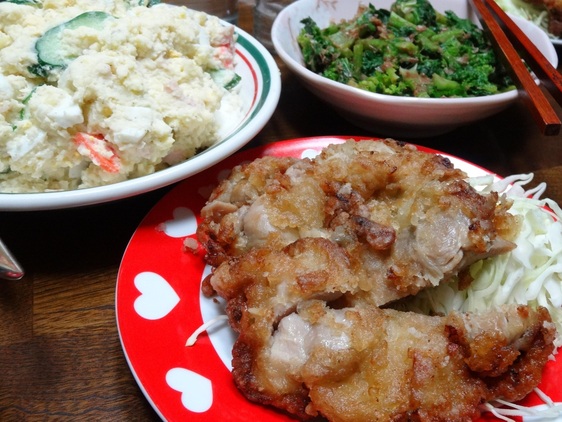 Delicious Sanzoku-Yaki, (山賊焼き) (deep fried teriyaki chicken thigh) with homemade greens It was this kind of utter generosity that made us feel like we were at a home far away from home. Arriving at Rika’s house her mother had brought us some of the local specialty, Sanzoku-Yaki, (山賊焼き) (deep fried teriyaki chicken thigh) and prepared fresh miso soup and greens. We waited until the evening for our friend Riko (also from Bodhgaya in India), who came up to join us from Chiba, near Tokyo. 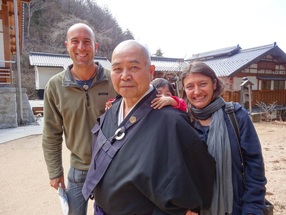 Rev. Ogasawara and his granddaughter Then it was off to a busy day as we headed to Kotaku-ji Temple to visit with Rev. Ogasawara (the senior priest from Bodhgaya, who had led the sesshin there). We enjoyed tea with him and discussed Zen before everyone got to try their hand ringing the temple bell! Then we headed off to Matsumoto Castle, which features the oldest five-tiered keep in all of Japan. The sun gleamed off of the “black crow”, named after the dark hues of the stained wood of the castle. Hitoshi-san (Rika’s Dad) told us about an interesting feature of the castle, which is that it actually has 6 floors (instead of the 5 you see from the outside), one of which is a hidden floor where gunpowder and other valuables were stored.
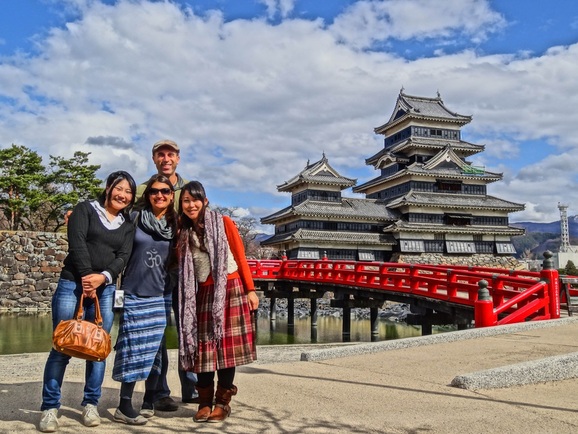 From left, Rika, Neda, Jeff & Riko enjoying a day at Matsumoto Castle On our return back to Shiojiri, we visited Toha-osho’s temple again, where he told us that he had spoken to the folks at Eiheji and they did have a foreign group visiting on April 1st and we could join them, if Toha-osho came along. So he told us he would drive us out to the temple (5 hours!), stay with us overnight and then head back. Sugoi! (Amazing in Japanese). Rika agreed to join us and we had our road trip/pilgrimage set!
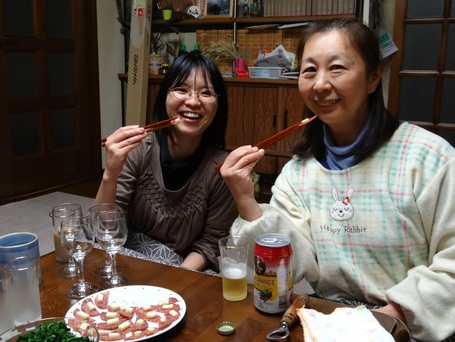 Chizuko-san and Humina-San try Bulgarian appetizers Japanese style (with chopsticks!) 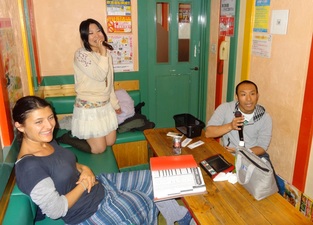 The next few days passed like a spring breeze as Rika’s brother Shu-san, sister-in-law Humi-san and little niece Yuki came to visit for the weekend. We had an amazing time as we cooked them a Bulgarian meal (served Japanese style) and went out with Shu & Rika for a night of fun Karaoke (which for those who might not know, originated in Japan). The next day was all preparation as the family readied the “irori” for a grand feast that night. Their irori was built by Hitoshi-san and his father in a small separate house off the main house. It consists of tatami mats surrounding a special pit filled with sandy earth. Over the pit goes the grill, and when the fire is ready all sorts of delicious meats and veggies are lovingly cooked. We sampled tender grilled scallops still in the shell and finished off with some butter, marinated beef, Japanese mushrooms, succulent chicken legs, shrimp, and hand caught little sweet-fish that you eat whole. Toha-osho joined us for the gathering and on his way in, nonchalantly handed us some beautiful calligraphy he had made for us, despite being terribly busy with a funeral service over the past couple days. The night finished with the family sharing some special Cherry-blossom infused sake with us to try – the delicate blooms still floating in the fragrant liquid.
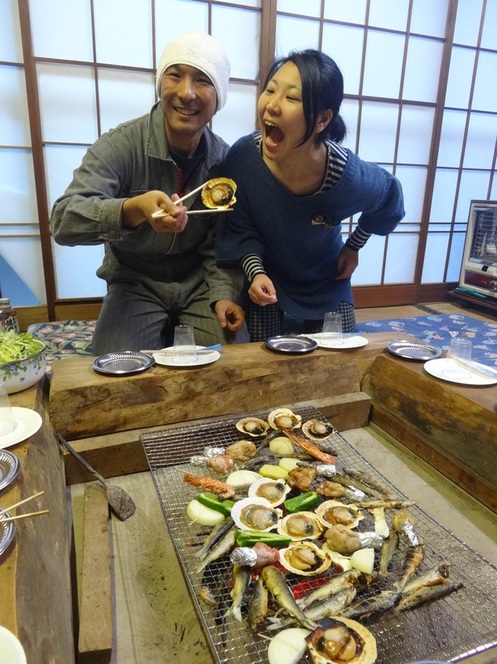 Rika enjoys a scallop from brother Shusuke-san during our irori feast! On Sunday, our last day together with the whole family, we took everyone out for Kaiten-zushi (sushi-train), which is adorable in Japan. Not only is there the normal sushi moving around the conveyor belts, but when you make custom orders it comes to you on a mini-bullet train (Nozomi Shinkansen) that stops at your table before zooming off to the next stop. Sugoi! 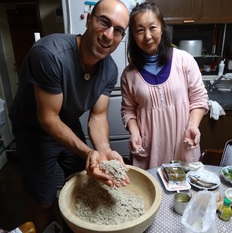 The evening was another highlight as Chizuko-san, Rika’s mother, took us into the kitchen and taught us how to make home-made soba noodles. We learned to serve them warm where they are dipped into a vegetable laden soup with a bamboo strainer. But the local specialty is to serve them cold on a bamboo basket (zaru-soba) where you eat the noodles by dipping them into a light soy broth and then quickly slurp them into your gullet! Hitoshi-san showed us how it was done brilliantly the first time, but I wanted to capture it on video. Sufficed to say, the 2nd attempt wasn’t as cleanly executed, but it made for this hilarious video!
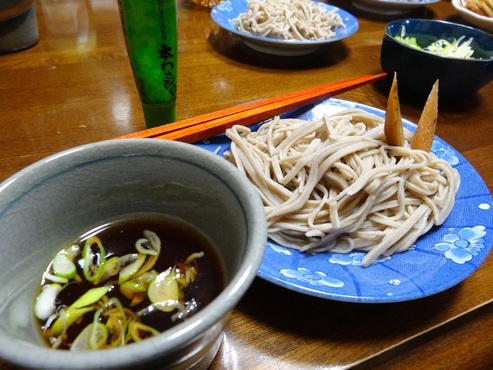 Our homemade zaru-soba! Note that the thicker noodles were the attempts by Neda & me! You might be wondering by now why this post opened with the story of Mahakasyapa. In the story, Mahakasyapa is the only disciple to understand that connecting deeply to the reality of all things is not dependent on words, but comes only from direct experience. A corollary of this lesson could be that our connection as human beings is also not dependent upon words. There has been no time where we felt this more deeply than at Rika’s house, where other than Rika, no one else in the family spoke more than a few words of English! Here we were bonding with the family, cooking together, playing with the little Yuki-monster and yet not actually communicating in words. We truly felt like a part of the family and yet we hadn’t actually ever “spoken” to anyone in the family besides Rika. The experience taught us the power of just being present together to bind and connect people in a fundamental way. We left the family laden with gifts of calligraphy and art that Chizuko-san and her teacher had made and with heavy hearts that the time had passed so quickly. Toha-Osho came for us at 5am to start the road trip to Eiheiji. Chizuko-san (by now called Mama-san) made some coffee and tea and she and Hitoshi-san (who we called Papa-san) saw us off as we left for the next adventure! To see all the pics and videos of our time in Shiojiri and Matsumoto click here: 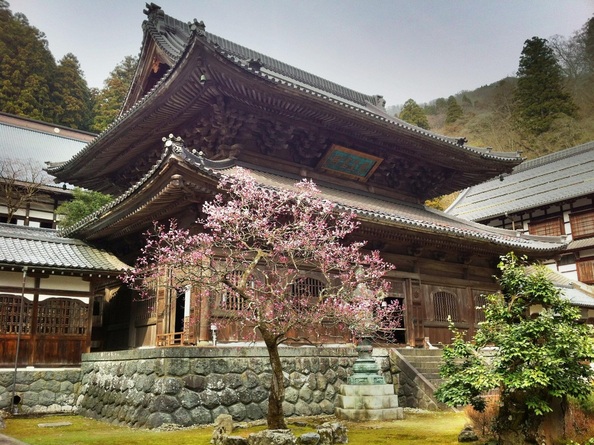 Butsuden at Eiheiji Eiheiji is perhaps the most important place of pilgrimage for Soto Zen practitioners. It is here that founder Dogen established his training monastery in 1244 and where his first writing, the Fukanzazengi (Universally Recommended Instructions for Zazen) is stored. Today it is a full training monastery with over 200 monks in residence.
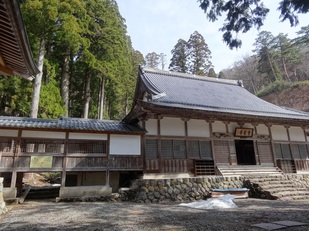 But we didn’t go straight to Eiheiji – instead Toha Osho took us on a historical tour of Zen Buddhism in the region, taking us first to the remote Hokyo-ji Temple, which was founded by Dogen’s friend and student, Jackeun after Dogen’s death. It is unique because it is one of few Zen temples founded by a foreigner and was founded after a schism at Eheiji over leadership caused Jackeun to leave. Jackeun’s students would continue to lead Eiheiji until 1468 when the lineage of Keizan (who founded Soji-ji temple) assumed leadership.
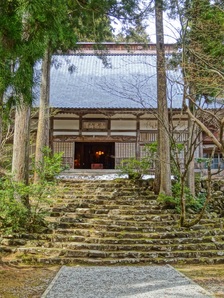 Next we visited Kippo-ji, a temple where Dogen lived over a cold winter in 1243, writing many parts of the Shobogenzo during that time. It is important in Zen practice because it was during this time that Dogen started to elevate monastic practice over lay practice. It is thought this may have been because the winter had caused the monks’ morale to be very low and that Dogen was attempting to inspire them while Eiheiji was being built. Interesting how even great Zen Masters have to make compromises to keep popular support, huh? One of the most memorable parts of the visit to the monastery was a flat rock in the back of the grounds were it is said that Dogen meditated.
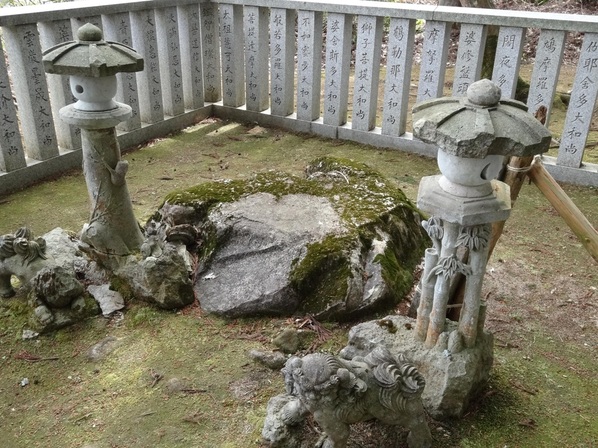 Dogen's meditation rock at Kippo-ji. The writing on the pillars behind lists the lineage of teachers reaching from Buddha to Dogen 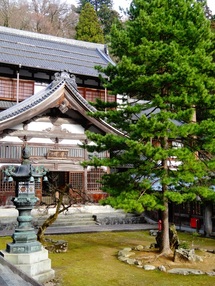 Finally, we made it to Eiheiji, a temple completed only 10 years before Dogen’s death. It was his realization of a dream to have an ideal training monastery nestled in the mountains and rivers of nature. Rev. Kuroyanagi, head of international students, had come from his home temple in Nagano to lead a group of Karate practitioners on a tour of the temple and to receive and introduction to zazen. We knew the zazen part, but we still appreciated seeing the Joyoden (founders hall), where Dogen’s remains are interred and to practice the morning service in the Hatto (Dharma Hall). It was quite an experience to walk down the isle to offer incense while surrounded by the reverberating chants of 200 Zen monks. They even offered my name during the chants for well-being (my name had been on the register of guests). While doing all of this, Toha-Osho cheerfully tagged along and pointed out tiny aspects we might have missed (he practiced at Eiheiji when he was younger). We felt such tremendous gratitude to this man who had sacrificed his time just to show a couple of foreigners around this special temple!
One further note on Eiheiji – it was the first time we had seen a Japanese Soto Zen monastery functioning fully with monks and it made us truly appreciate the training we had received at the Austin Zen Center under our teacher Seirin Barbara Kohn. We understood all the forms they were using at the temple and in many ways it felt a bit like home. Barbara did a great job of creating a little microcosm of a Zen monastery right there in the heart of Austin! Strangely, American Zen Centers now seem to retain the forms and practices of Eiheiji and Soto Zen to much greater extent that temples in Japan, which have largely become places for ceremonial practices rather than zazen and zen training. 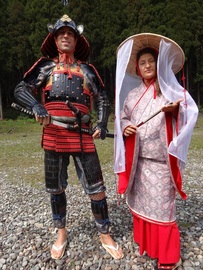 When the morning came (bright and early at 3:30am!) and zazen, services, and breakfast were over, we left Eiheiji and thought we would head to the station to say our goodbyes. But Toha-Osho had one more surprise in store for us. As we all nodded off to sleep (we only slept 3 hours or so the previous night) he took us to the Ichijodani Asakura Clan ruins, where they have reconstructed the town built up around the Asakura Family Mansion, which was burned down by Oda Nobunaga in 1568. There Toha-Osho and Rika cajoled us to don a samurai costume for Jeff and a kimono for Neda, making for some of the most hilarious pics on the trip so far! See all the pics of our pilgrimage to Eiheiji here!
Our time with Toha-Osho, Rika, and her family, was inspiring beyond words. It showed us the power of love and generosity to shine through even when there is almost no connection through language. It was a metaphor for all of Zen practice for us – to find compassion and wisdom beyond words and letters and to thereby live more authentic lives. There is no greater gift. Domo arigato gozaimasshta!
The cherry blossom tree, or sakura, holds special significance in Japanese culture. They bloom for only a week or two in the springtime and the lack of any green parts of the plant results in the delicate snow-white blooms transforming ordinary streets into magical pathways of ephemeral beauty. Indeed, the cherry blossoms have a distinctly Buddhist symbolism in that they produce stunning beauty for a short time before their flowers float down to the earth. As the famous Haiku poet penned: simply trust!
cherry blossoms flitting
down
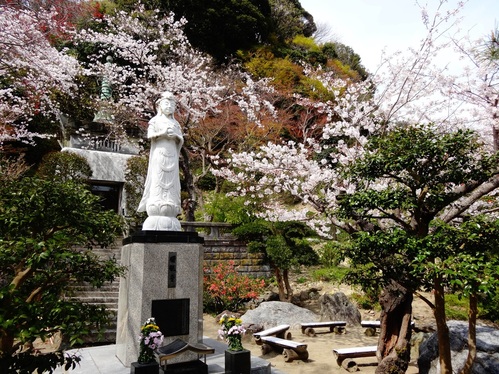 Kannon (Avalokitesvara) at Kencho-ji Temple, Kamakura Issa points out the essence of the cherry blossom teaching. It is not just the fact of our transient nature, our limited time on this earth. It is the movement of surrender to that nature and the contentment that comes from trusting in it. To appreciate time’s inexorable hold over us and our ability to transcend it by embracing it.
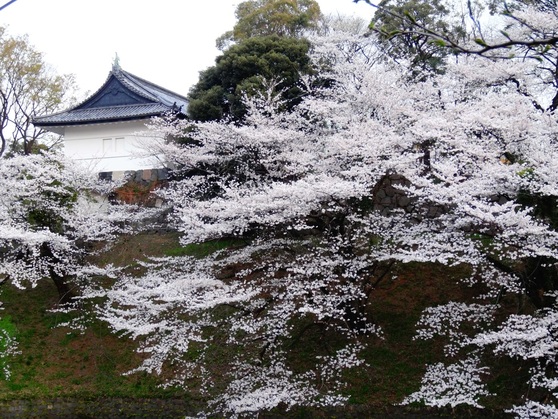 Cherry Blossoms lining the moat of the imperial palace 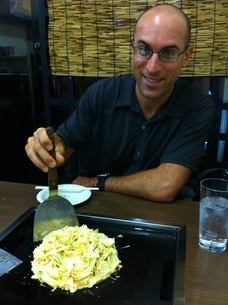 Could we have been any luckier? We arrived in Tokyo to find the cherry blossoms (sakura) in full bloom – nearly two weeks earlier than expected! We arrived at our hotel late in the evening and as we walked to reach it, we saw our first cherry blossom tree – leaves twinkling in the light like the season’s first snow. That night we got our first taste of real Japanese cuisine (the kind you don’t find in America) when we stumbled into a little restaurant and asked in broken Japanese what they recommended. The hostess/proprietor came out with a bowl full of cabbage, shrimp, squid, cheese, egg, and flour mixed with water. We were supposed to cook it ourselves on the teppan (grill) in front of us, but when she realized our ignorance she helped us along, plopped it all down and expertly cooked it so that within minutes we had delicious Okonomiyaki! I think of it as a Japanese omelet, but they called it Japanese pizza.
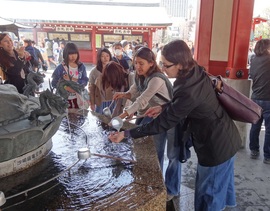 Ritual washing Ritual washing Our first day in Tokyo we walked down to the Asakusa area, home of the famous Senso-ji temple. Senso-ji is a Tendai Buddhist Temple and is the oldest temple in all of Tokyo. Feeling serendipitous in our timing yet again, we were able to meet up at Senso-ji with Neda’s cousin Iliyana, who was leading her family on a tour of Tokyo that week. What a coincidence to be able to meet up with Bulgarian family half way across the world! Illiyana and her old classmate Heidi showed us how to ritually wash our hands and mouth and also how to cleanse ourselves with incense smoke before making an offering to the statue of Kannon (their version of Avalokitesvara, bodhisattva of compassion). A little mystical for us pragmatic Zen practitioners, but an enjoyable culture experience nevertheless. The temple also featured a beautiful stroll garden called Denbo-in, which bursting with cherry blossoms, made for a contemplative walk.
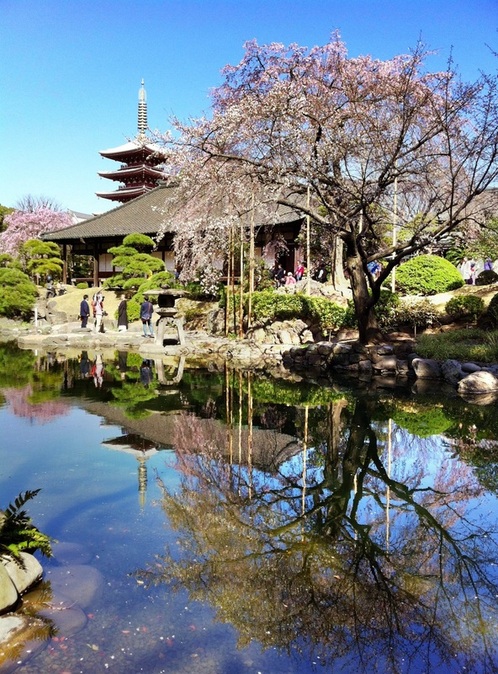 Denbo-in stroll garden with views of the 5 storied pagoda of Senso-ji From Senso-ji we cruised down the Sumida River, enjoying a view of Tokyo by the waterway which used to be the predominant transportation veins of the city. We capped off a busy day back at our hotel, which was hosting a cheerful sushi making party! The staff patiently showed us how to make sushi rolls and also fed us delicious sashimi and nigiri. The next day, it was time to head off to the most famous cherry blossom viewing area in Tokyo – the expansive Ueno Park. Our hotel was located between Ueno and Asakusa, so we were able to walk to Ueno as well that day. It was a Saturday morning and the massive park was as crowded as a subway train during rush hour. Yet everyone’s head was craned slightly upward and there was a quietly reverent tone to the whole affair as the cherry blossoms painted white brushstrokes against the overcast sky. It was truly absorbing – as the famous Zen poet Basho wrote: Clouds of cherry blossoms!
Is that temple bell in Ueno
or Asakusa?
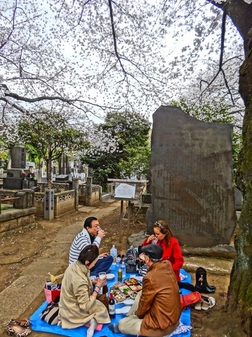 The only break in the quiet came from the picnickers who had set up tarps under the trees and were busy eating, drinking, and laughing. These impromptu gatherings are called Hanami, which roughly translates as “cherry-blossom viewing parties”. It is seen as a celebration of our cherry blossom nature to gather under the trees with friends and loved ones and celebrate life and beauty even as they are passing away above us. The spiritual intonations of Hanami were even stronger as we walked north to Yanaka cemetery, where the graves of the city’s famous citizens were lit from above by the blossoms. Even alongside the graves Tokyoers had set up their tarps and were toasting life while sitting next to reminders of death. Truly a Buddhist party!
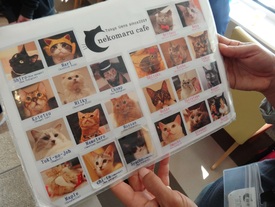 After all that walking we needed to relax and thought it was the perfect time to seek out a uniquely Japanese relaxation technique we had heard about on NPR several years before. We rode the elevator to the 8th floor of a building near Ueno station and the doors opened to a truly quixotic scene. A cat café! Walking into brightly a lit room full of cat toys and furniture, we were given a “menu” to peruse the names of the different cats that were available for viewing, playing, and cuddling. Some Japanese people sat sipping coffee and gazing at the cats, others snapped photos or played with them. Having experienced a bit of kitty deprivation recently as we’ve been too long away from our little Brandy cat, we jumped right in and played around with the cuties. But not for too long, the cat café charges about $4 per person every 15 minutes so the prices can add up. Only in Japan, where apartments are often too small to have an animal and the people have an inordinate love of cats, could this business survive!
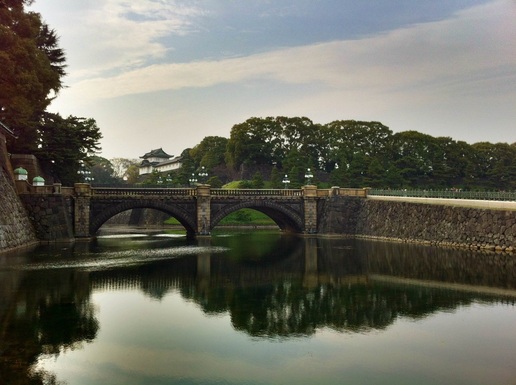 Imperial Palace 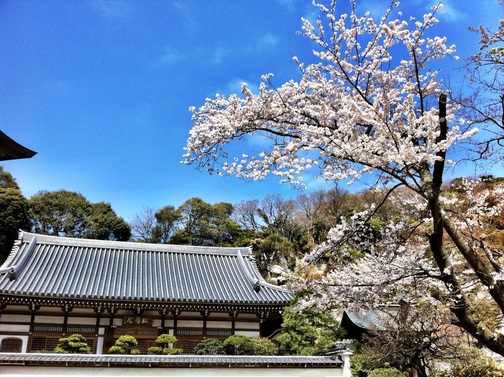 Engaku-ji Temple, Kamakura 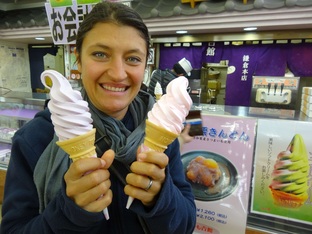 Sweet Potato & Cherry Blossom Ice Cream! Sweet Potato & Cherry Blossom Ice Cream! Our last day we took a day trip out to Kamakura, which was Japan’s first Shogunate Capital from 1185 until 1333. Founded by famous samurai Minamoto no Yoritomo, Kamakura became a bastion for Rinzai Zen and contains many beautiful temples. We visited the largest of those temples, Engaku-ji and also the oldest training monastery in Japan, Kencho-ji. Then we walked along the streets of Kamakura City and tried their famous sweet potato soft serve! The Japanese have wonderfully different flavored soft serve here with some of our favorite flavors so far being green tea matcha, black sesame, and the seasonal cherry blossom flavor!
No visit to Kamakura is complete without viewing the ancient Daibutsu (Great Buddha) cast in 1264 that uses distorted proportions to make it appear balanced (a use of perspective that may show Greek influence via the Silk Road). The 44 foot tall Buddha sat gazing at a beautiful cherry blossom in bloom, bring another Issu haiku to mind: the Buddha too
looks this way...
cherry blossoms!
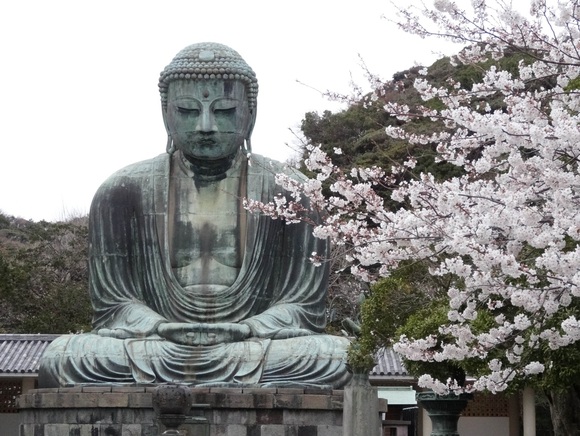 Daibutsu (Great Buddha) Statue - Kamakura Japan marks the beginning of the end of our grand adventure. We have tickets booked to Seoul and then Istanbul before we return to Bulgaria for the summer. Our time in Tokyo was a perfect reminder to enjoy each moment of the trip because the days will fall like blossoms caught in the wind…
The wind has settled, the blossoms have fallen;
Birds sing, the mountains grow dark --
This is the wondrous power of Buddhism.
Zen thought is rife with the theme of interconnectedness, sometimes called dependent co-origination. The basic idea is that everything in the world arises together and only exists together through a delicate balance of certain causes and conditions. As any one thing changes, so does everything else in the world. Perhaps the most famous metaphor in Buddhist thought for this idea is Indra’s Net. Francis Harold Cook, in his book Hua-Yen Buddhism: the Jewel Net of Indra, describes the net as follows:  Indra's Net - Copyright Gail Atkins "Far away in the heavenly abode of the great god Indra, there is a wonderful net which has been hung by some cunning artificer in such a manner that it stretches out infinitely in all directions. In accordance with the extravagant tastes of deities, the artificer has hung a single glittering jewel in each "eye" of the net, and since the net itself is infinite in dimension, the jewels are infinite in number. There hang the jewels, glittering "like" stars in the first magnitude, a wonderful sight to behold. If we now arbitrarily select one of these jewels for inspection and look closely at it, we will discover that in its polished surface there are reflected all the other jewels in the net, infinite in number. Not only that, but each of the jewels reflected in this one jewel is also reflecting all the other jewels, so that there is an infinite reflecting process occurring."
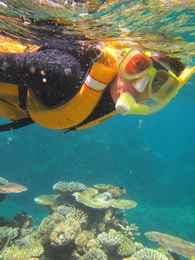 Neda on the reef Enter the Great Barrier Reef. Composed of billions of tiny organisms called coral polyps, the reef is the largest single structure made by living organisms and the only one that can be seen from space. As Neda & I swam through the reef and witnessed its dazzling hues, it occurred to us that it is a living embodiment of Indra’s jeweled net. Literally billions of animals swim in an intricate dance that is both awe-inspiring and yet also extremely delicate. It took millions of years for the reef system to form - for the net to be woven as it were. But current threats to the reef show us that just a few of the jewels breaking are enough to make them all stop shining.
The threats are numerous. Shipping traffic over the reef is quite high and accidents occur too often. The last major accident was in 2010 when the Chinese bulk coal carrier Shen Neng 1 was traveling outside the regulated shipping lane and struck the reef, scraping along its surface and creating a 3 kilometer scar where no marine life lives anymore. 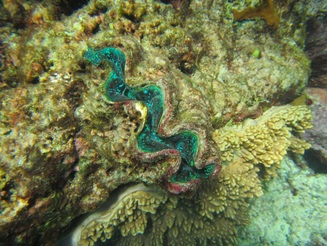 A beautiful giant clam
With the Australian economy booming from coal exports sent to support China’s voracious industrial machine, shipping accidents will only increase. The Australia coal industry has plans to build another 9 coal ports along the Australian coast, increasing even further the traffic passing through the reef. Many of these ships use a chemical called Tributyltin, which preserves the condition of ship hulls, but is toxic to the sea life it touches. The increased traffic will also increase the oil spills that occur on the reef – there have already been 283 spills on the reef since 1987.
Global warming is another threat to the reef that is already occurring. Warming waters are killing off the algae that populate the coral (which are what give the reef its vibrant colors). As one might expect from the Indra’s net analogy, the damage to the algae results in the death of the animals that use it as their food source and so on down the food chain until all that is left are “bleached” corals devoid of color and of life.
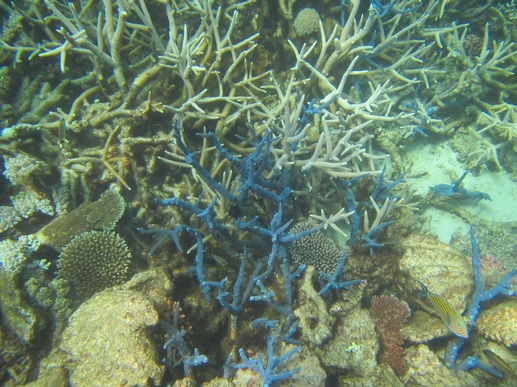 bleached corals? The most iminent threat comes from the burgeoning numbers of Crown of Thorns starfish attacking the reef. These bad boys latch onto coral and eat its tissue. A high enough concentration and whole sections of the reef can be rendered lifeless. The high numbers of the starfish are believed to stem from the agricultural run-off in the area feeding the algae that the Crown of Thorns starfish eat.
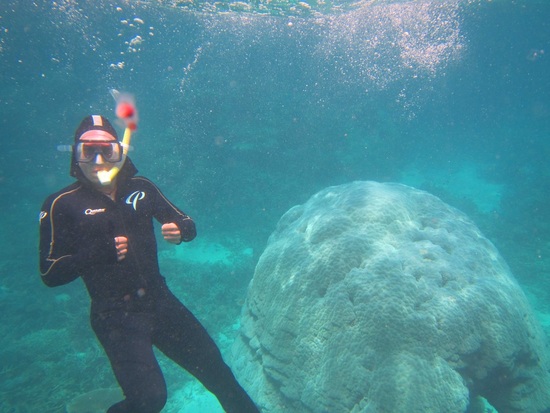 Jeff with a 3,000 year old "boulder coral". These guys take hundreds of years to build each subsequent layer... 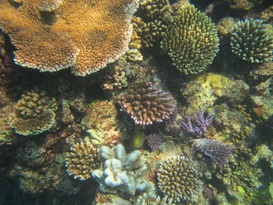 All in all, I know this paints a grim picture for the reef and is perhaps a rather sad illustration of Indra’s net. Experts seem to believe that it is quite possible the reef will only be a natural wonder enjoyed by the next generation or two humans before becoming part of the history books. According to a 2012 study by the National Academy of Science, since 1985, the Great Barrier Reef has lost more than half of its corals with two-thirds of the lost occurring from 1998 due to everything discussed above. But that doesn’t mean there isn’t something you can do, regardless of the odds. For more information on positive change you can make, click here.
Indra’s net is a powerful concept that can be explored at multiple levels. The ecological example of the reef proves how interconnected our lives are with the billions of lives that surround us. Perhaps you can’t singlehandedly save the reef, but think about how you can apply the analogy to other parts of your life. You are a jewel in the net, reflecting outward to all the other jewels. Perhaps the smile you give a stranger changes her day for the better and affects her husband, kids, co-workers, etc… In what other ways can you spread light through the net instead of watching as the darkness comes?
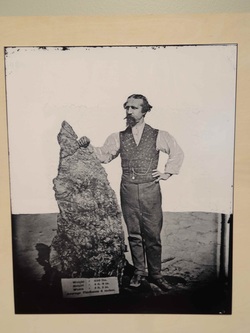 The biggest nugget of gold Melbourne is a city born out of gold. Originally founded via settlers from Tasmania, the city was a small farming settlement until the discovery of gold inland in the state of Victoria. The gold rush led to the city doubling in population within a year and continuing to grow and boom for nearly 40 years – a time when Melbourne was known as a “working man’s paradise”. By the end of the boom in the 1890’s Melbourne’s population was nearly half a million and for a time it was the 2nd largest city in the British Empire after London. For me however, Melbourne was more interesting in its connection to our personal history because Mick McKiterick lives there. Mick was a good friend of mine when I studied abroad at Utrecht University in 2002.
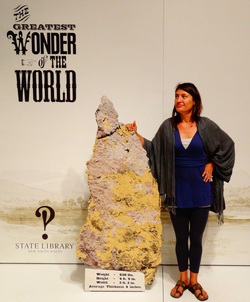 Neda does her version of the pose Back then I was studying philosophy with several mates in Utrecht and Mick was studying law. We had great times contemplating philosophical and ethical issues while coming of age in the charismatic Dutch city. I most recently had seen Mick in 2005 when a visit to St. Louis saw us heading to a pub-crawl together with good friend Josh Finnell, who had also studied at Utrecht with us as well. On that fateful evening, I would meet a charming Bulgarian girl who liked to sing karaoke and throw back shots of tequila. Add to that her intoxicating laugh, quick smile, and generous heart and it wouldn’t be long before I asked her to marry me…and the rest is history! By being there on that special night, Mick has always had a place in Neda & my relationship mythology. To add to this dynamic, it is a particularly exciting time in Mick’s life as well as he is due to marry fiancée Marlene this coming May. Sufficed to say, we were excited to reunite on his home turf and meet his wife-to-be.
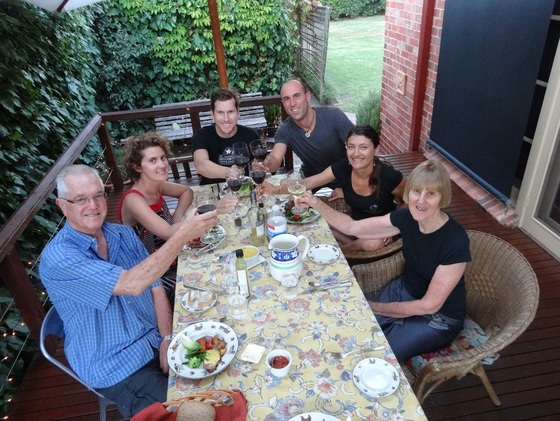 Dinner in Echuca with Mick, Marlene, Terry, and Allison 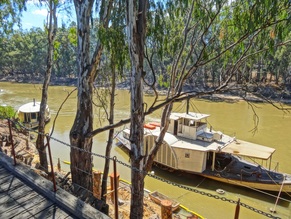 Old Steamer on the Murray River The adventure started with a weekend trip out to Echuca, Mick’s home-town. There his Mom Allison treated us to delicious baked cookies and cakes (thus the sugar in the title). Both Allison and Mick’s Dad Terrence opened up their home to us and we shared delicious food and good conversation. Marlene, Mick, Neda and I also floated down the Murray River while enjoying the Aussie Labor Day.
With the weekend ending, Mick & Marlene generously loaned us their car and their camping equipment and we set off on the Great Ocean Road along the coast of Victoria. Built as a way to give jobs to returning WWI servicemen, the road winds its way down the coast passing stunning sea formations at multiple points. Hikes in the area feature the history of the Shipwreck Coast (over 50 ships were lost in the area between 1836 to 1940) as well as the beautiful limestone and sandstone rock formations of the Twelve Apostles, the Loch Ard Gorge, the Grotto, and the London Bridge. The Loch Ard Gorge is named for a ship that wrecked there in 1878. The only survivors were a ships apprentice who was washed up into the gorge and then rescued a woman who had also washed up on a piece of wreckage nearby.
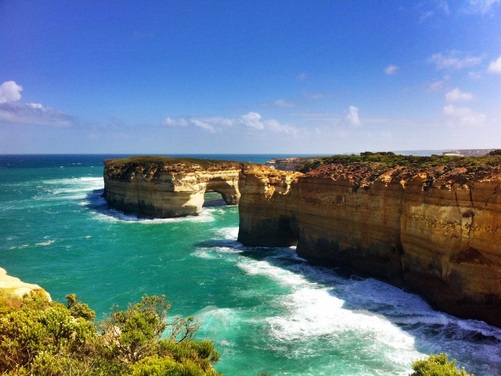 Loch Ard Gorge 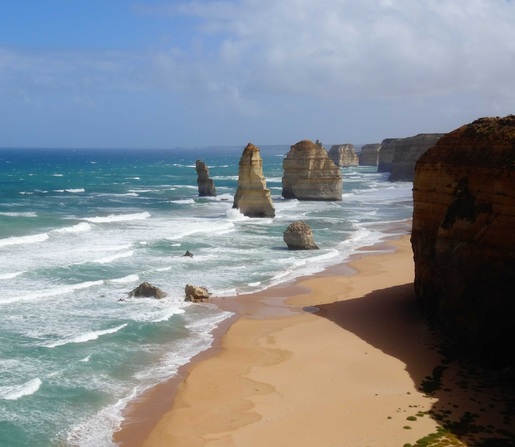 The Twelve Apostles 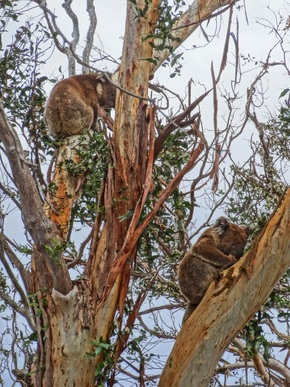 Koalas huddled in trees Another highlight along the Great Ocean Road was camping in the Cape Otway National Park. The campground itself at Blanket Bay was filled with flies and not the most comfortable, but on the way out we saw heaps of cuddly Koala Bears huddled in the trees. But most of them were seemingly passed out as they nestled in the trees. Why you ask? It turns out that koalas only eat eucalyptus leaves, an ecological niche that they have cornered because the leaves are tough, oily and difficult to digest. This turned out to be a particularly good niche for them because the leaves act as a mild narcotic to the koala’s biology which means they are basically hanging out high all day long. With this in mind we felt lucky to see a few of the critters wake up out of their daze and forage along the branches for another “hit”.
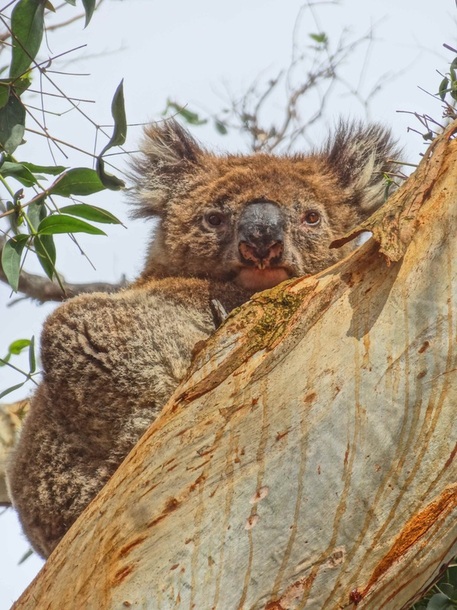 Look at that koala face! This one loved the camera! 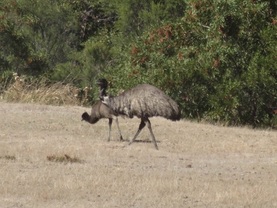 Emus at Grampians Natl Park Neda and I camped in Port Fairy at the end of the Great Ocean Road and had a romantic evening of ice cream and strolling around before waking early the next morning to head off to the Grampian National Park. We passed through the Brambuk Cultural Centre where we learned a bit about the aboriginal population who used to live in the park’s area and also saw some Emu in the wild. Then we pounded off on some great walks including the Pinnacle Walk, which passes through the Australian “Grand Canyon” on a fun rock-hopping hike. We also enjoyed the Boroka and Reeds Lookout walks and were dazzled at the end of the day by the sun piecing the mist as it shined down on majestic McKenzie Falls.
That night we bedded down at Trooper’s Creek campsite and some local kangaroos came around looking for some chow. Neda and I gave them some shredded carrots and got up close and personal with these fascinating marsupials! The next morning we headed to Hollow Mountain for a morning hike. We climbed over rocks formed under water millions of years ago and lifted up during the formation of the continent. The water had left fluid marks on the rocks that made this hike incredibly unique and interesting to explore. The morning sun also shone wonderfully off the tangerine orange cliffs, making for some great photos! 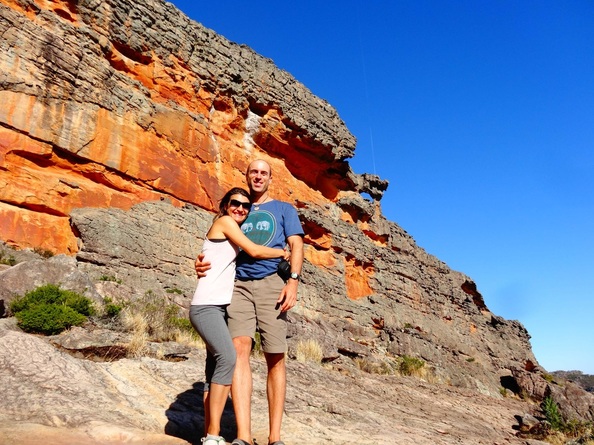 On top of hollow mountain 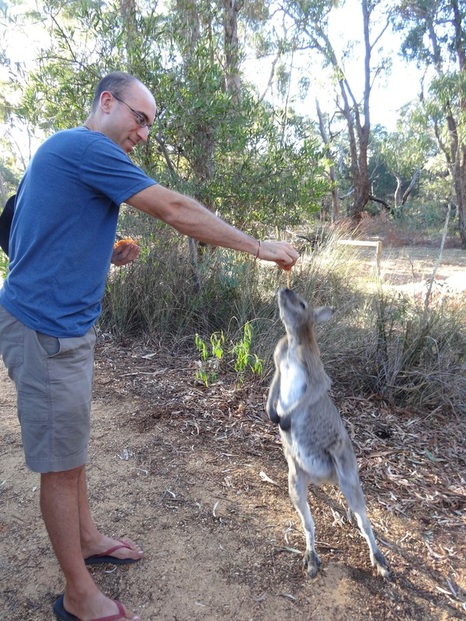 Feeding the roos! 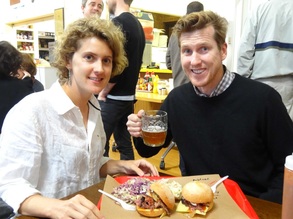 Mick & Marlene with some BBQ We returned to Melbourne to a delicious homemade pesto pasta dinner with our generous hosts – Mick and Marlene – and a wonderful evening of chatting and catching up. Saturday morning, Mick took us to his yoga studio for a great class to start off the weekend and after we explored some of the hip Melbourne neighborhoods. That night we celebrated Mick’s birthday at the local bowling club (rain made for no bowling) which had delicious BBQ (the closest to Texas we’ve had)! We were amazed at the moist smoked brisket at Fancy Hanks and painfully missed our old hometown of Austin. The next day, we explored Federation Square and enjoyed Thai and Greek festivals, Chinese dumplings, and many cute lanes (Aussie for alley) decorated with street art, and packed with hidden restaurants and bars and street performers. Mick and Marlene, thank you so much for your hospitality! It was solid gold!
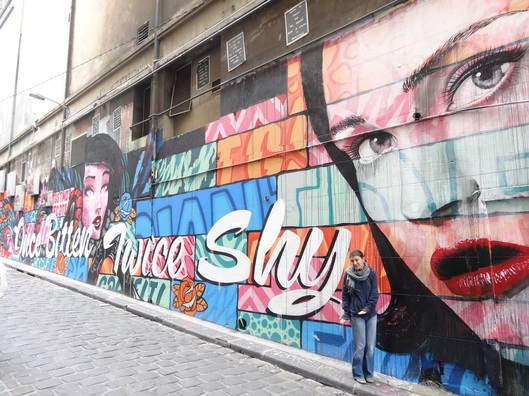 Hosier Lane Street Art
Sydney – can one place better epitomize mankind’s egregious sin as well as her capacity for redemption? In the middle of January 1788, the first fleet of settlement ships landed on the coast of the massive continent at Botany Bay, which Captain Cook had suggested as an ideal settling place when he explored there in 1770. Finding Botany Bay ill suited for settlement, Captain Arthur Phillip sailed down the coast a bit and found that Cook had overlooked the area known as Fort Jackson. Far from a tiny inlet, as Phillip sailed inward he discovered one of the greatest natural harbors in the world and the city of Sydney was born.
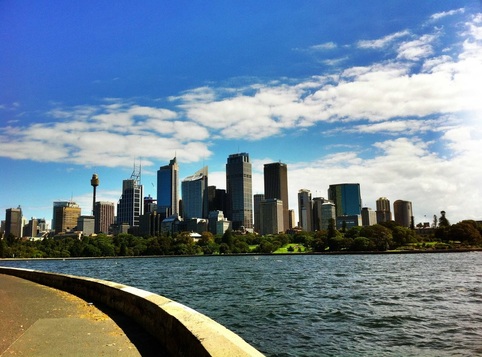 Sydney on a beautiful sunny day 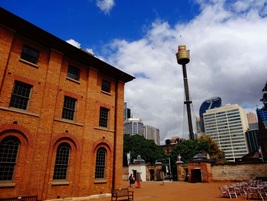 Hyde Park Barracks from convict times A full half of the contingent of 1,500 settlers were convicts sent from Britain. Why was Britain sending so many convicts to Australia? The answer is twofold. First is the so-called “Bloody Code”, the legal system in Britain at the time that carried the death penalty for over 222 crimes, including cutting down a tree, stealing goods worth 5 schillings (scarcely above the cost of a loaf of bread), or stealing fish from a river. The legal system was so draconian (particularly towards the poor) that magistrates often downgraded the punishment to transportation rather than death in an effort to circumvent the code. Convicts were also sent for political reasons. For example, nearly a 1/3 of the early convicts sent to Australia were Irish Catholics whose land had been taken during the Protestant “settlement” of Ireland (see the Fields of Indulgence Post “Weeping Buddha, Smiling Buddha” for more insight into this issue). At that time in Ireland, strict laws prevented Catholics from traveling more than 5 miles from their home, entering university, or being able to vote. Many were forced to a life of crime to survive – crimes punishable by transportation off the island or death. Other convicts sent included pirates, pickpockets, and women with “loose morals” ( who often were just women who had intentionally offended authorities in order to travel with their husbands). The 2nd reason for the large shipment of convicts to Australia (nearly 160,000 people in total between 1788 and 1868, when penal transportation ended) was that a certain colony now called the United States of America had rebelled and stopped accepting the transportation of prisoners that England had previously sent to its shores.
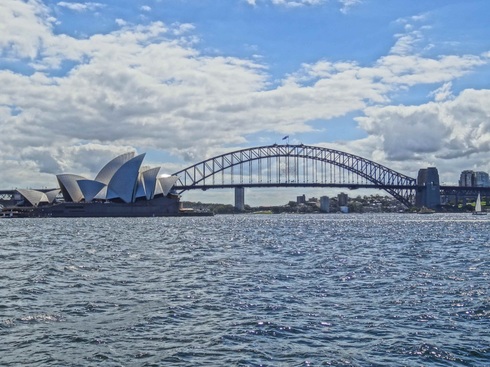 Sydney Harbor Bridge and Opera House The sins of Sydney’s past didn’t stop with the largely unjust transportation of convicts, but also lie in the terrible way they were treated in the first years. Many arrived to the continent half starved and quickly died while those who survived could be beaten mercilessly or hung for minor offenses while the female population of convicts was routinely sexually exploited.
But perhaps life for the convicts wasn’t so bad compared to the treatment of the Aboriginal populations. Having declared the land “terra nullius” (land belonging to nobody) due to the lack of agricultural activity present on it, the British essentially justified the invasion and destruction of the native population, who had lived there for an amazing 60,000 years prior to any Europeans arriving. The Aboriginal population consisted of over 250 distinct tribes, each with different languages and customs. Captain Cook, upon his discovery of the natives, speculated they might be happier than Europeans. Maybe it’s not surprising when the average aboriginal week consisted of about 20 hours of hunting/gathering with the rest of the time devoted to arts, music, and social activity. Granted living conditions were arduous, but could Europeans have learned something from this simple living rather than just destroying it for their agrarian machine?
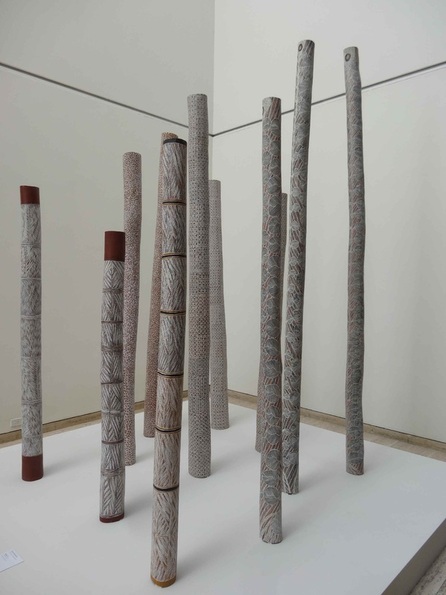 Didgeridoo art display in Museum of New South Wales Unfortunately, early friendly reactions towards the Europeans by the Aboriginals (who thought the settlers were ancestors returned as ghosts – after all they were quite white) quickly turned sour as the colonists intentions became clear. There was to be competition for resources and land and the locals were ultimately considered to be in the way. Early efforts by Governor Phillip to mediate with the locals ( most notably by kidnapping, acculturating and later befriending an Eora tribesman named Bennelong) eventually fell apart as smallpox decimated the local population, leaving hundreds of native bodies floating in the harbor in the early years. As Europeans continued to settle on Aboriginal land, guerilla warfare broke out and hostility would rule the day from then onward. 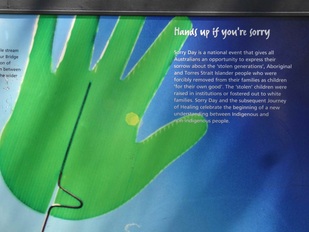 National Sorry Day This violent attitude towards the Aboriginal population may have reached its most disgraceful point between 1910 and 1970, when nearly 100,000 children were forcibly removed from their Aboriginal families to be placed in mixed-race children in orphanages, boarding schools or white homes. The idea was to promote assimilation, but the end result was to cut the children off from their culture, leaving them alienated both from their own people and the foreigners with whom they were thrust. This “stolen generation” has left a gaping wound in aboriginal culture today and has left many native people disenfranchised, unemployed, and isolated as they have been moved off the land they traditionally roamed upon to be put onto government-run reserves (if your from America this sounds familiar). In fact, it wasn’t until the 1960s that Aboriginal people were even included in the national census and began making strides towards equality in the eyes of the law.
We’ve taken some time to examine the sin at the heart of Sydney’s history, but there are tales of redemption as well. By 1822 nearly half of the convicts who had been transported established themselves as landowners or tradesmen once earning their freedom through good behavior. James Squire, a convict transported on the first fleet for stealing several chickens, was to become the first man to cultivate hops on the continent. Squire ran a tavern, a butcher shop, and a credit union and his death in 1822 saw the largest funeral ever held in the colony, completing his move from “shame to fame”. His name is now attached to a brand of craftbrews in Australia. In fact, the move from “shame to fame” is something that many Australians take pride in today. It is considered quite “vogue” to have had a convict in your family history. It is proof that your ancestors turned things around in this new world down under. In regards to the Aboriginal population, redemption is a continuing process whose end result is far more murky than the turnaround the convicts achieved. The government has now recognized a National “Sorry” Day (later renamed the National Day of Healing) that has seen both whites and aboriginals joining together to recognize the injuries done and start the path towards healing. Though much can be said for the power of an apology, the question remains how a nation can ever recover from such violence? 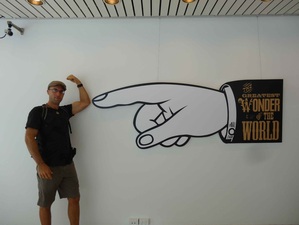 Goldrush Life Exhibit For Neda & me, Sydney was a welcome return to the big city after the rural adventures in New Zealand. Upon arriving, our generous couchsurfing host Gav cooked us up some kangaroo steaks (didn’t think I would eat a kangaroo prior to seeing one live in the wild!) and introduced us to the city. The next few days saw us walking the city as we explored the beautiful botanical gardens, the Hyde Park Barracks (where convicts were originally housed in the colony), and a fascinating exhibit at the Library of New South Wales on the Goldrush in Sydney. The discovery of gold in 1851 in Victoria would launch a massive goldrush on the continent, bringing in the wealth necessary to develop Sydney and Melbourne into the large cosmopolitan cities they are today.
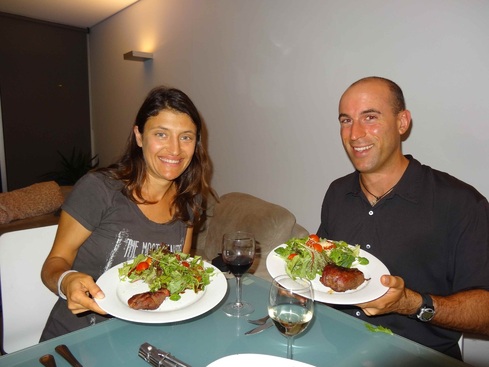 Kangaroo Steaks courtesy of our Couchsurfing Host - Gav We enjoyed some of that cosmopolitan spirit on our 2nd night in town with a visit to Victoria park for some slacklining with the locals followed by a hilarious improv comedy show at the University of Sydney, where we sampled the James Squire beer mentioned previously. Of course no visit to Sydney is complete without several different viewpoints of the architecturally stunning Sydney opera house and Sydney harbor bridge, which makes it the most beautiful harbor that we have ever seen. But beyond the bridge and opera house, the harbor is a truly massive affair, stretching 19km inland and providing access to many different areas via ferry. Neda and I took a day to explore one such area when we took the ferry to Manly beach and walked the harbor coastline from the Spit Bridge back to the city. We enjoyed sweeping harbor views as well as our first introduction to some interesting Australian wildlife like the St. John’s cross spider and the big water lizards living along the coast.
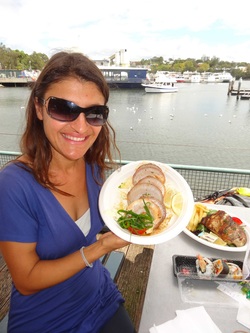 Fish market scallops We ended our time in Sydney with a visit to the local fish market where we sampled barramundi for the first time and delicious fresh scallops grilled in the shell! We also visited the wonderful museum of New South Wales, which features Aboriginal art as well as quirky exhibits displaying a variety of modernist and post-modernist art.
Our time in Sydney was a combination of appreciation for the society that has been built here and a feeling of deep loss for the civilizations that were displaced and destroyed. Still, Australia today is more multi-cultural than ever as it continues to work towards reconciliation with its first people, welcomes refuges from around the world and integrates its Asian neighbors into the cultural mix. It is a country working to fight its reputation as a “cultural backwater” by embracing the arts and globalizing its strong economy. It is a country that continues to strive towards a deeper awareness of the sins of its past while building a brighter future for all of its people. Redemption isn’t a tale that is told overnight, but rather a road that is laid brick by brick. There are many more bricks to lay, but at least the road is under construction.
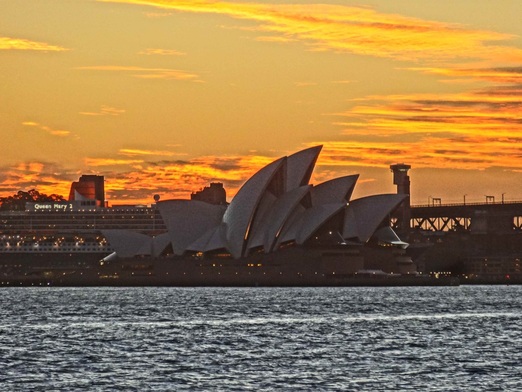 Sunset Cruise in Sydney
|

















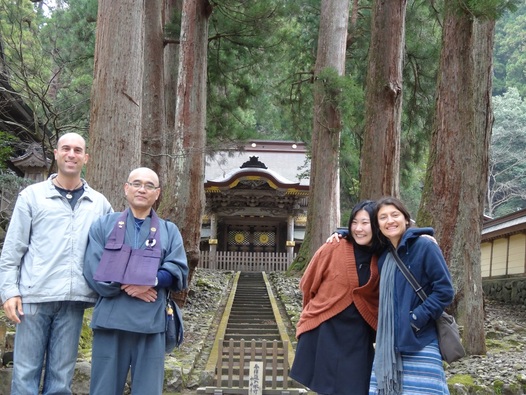
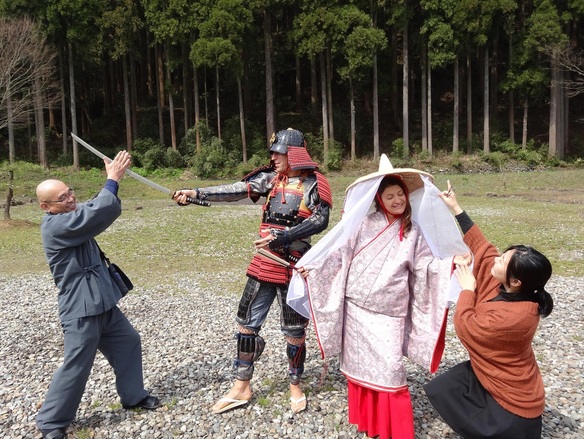
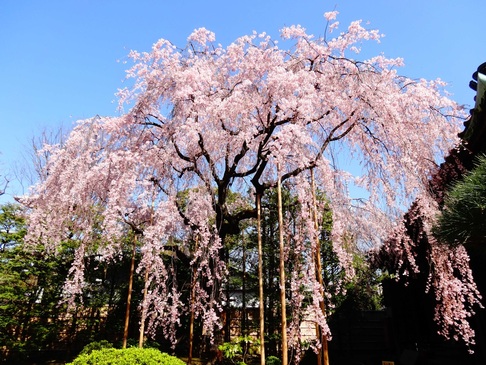





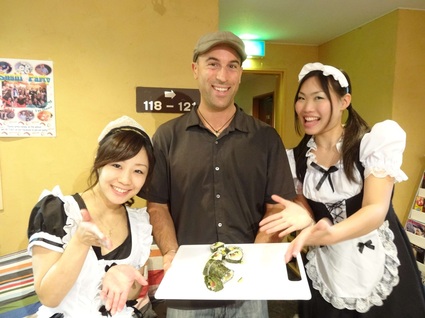
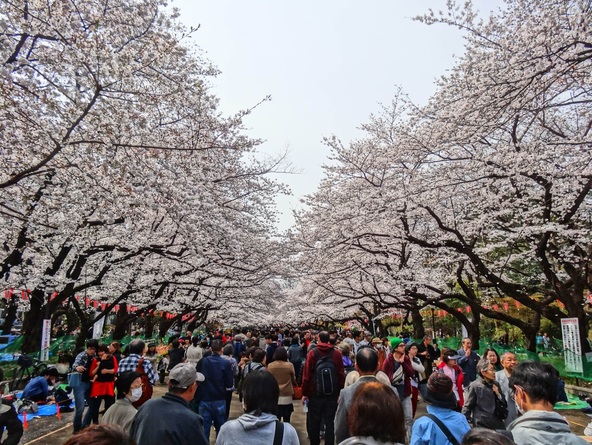


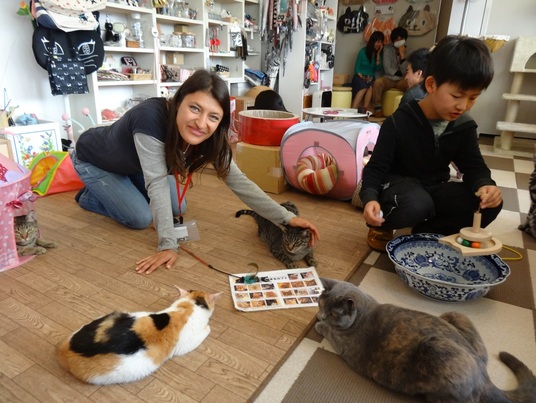




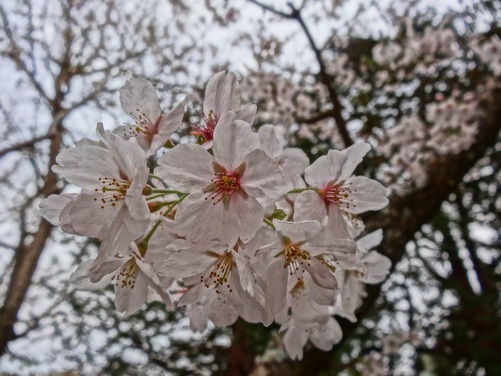

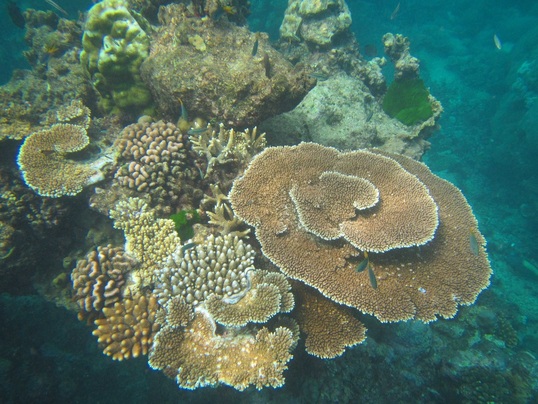

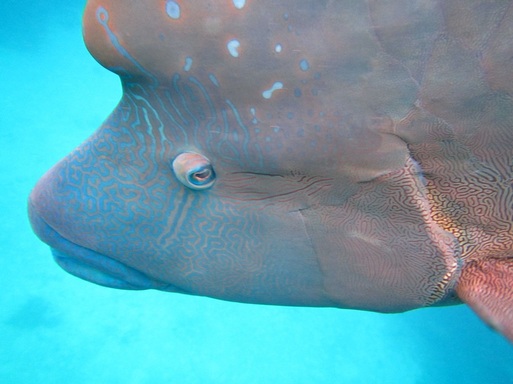




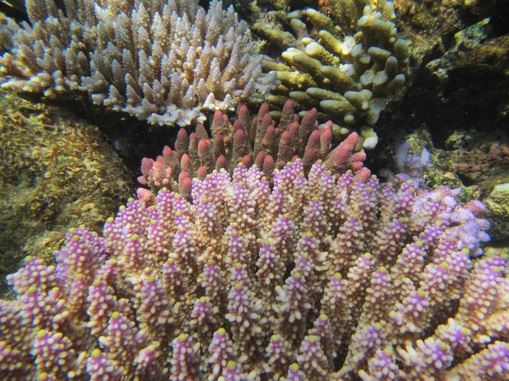
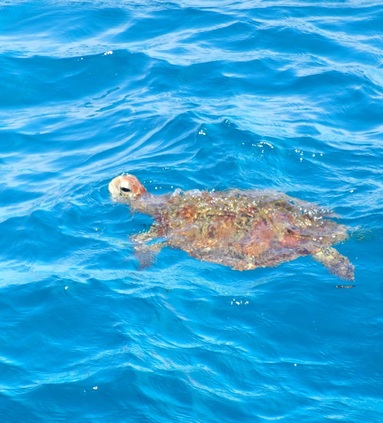









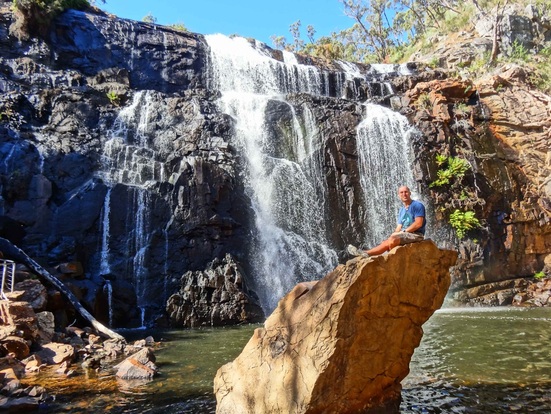











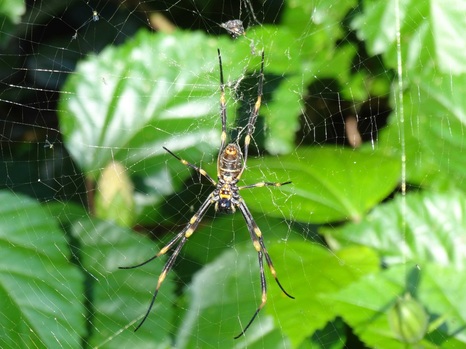


 RSS Feed
RSS Feed
